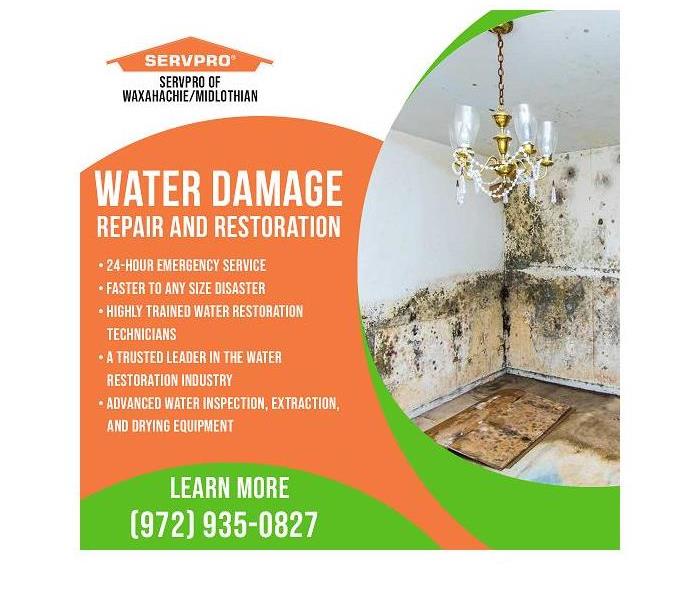Where Should Homeowners Look for Water Intrusion and Water Damage?
4/12/2021 (Permalink)
Blog Summary: SERVPRO of Waxahachie / Midlothian highlights seven hiding places where water can seep into a home and cause water damage.
The team of professionals at SERVPRO of Waxahachie / Midlothian knows that a water damage disaster can strike without warning, and water intrusion often goes undetected, leading to advanced secondary damage. When building materials such as plywood, OSB board, sheetrock, and insulation are subjected to water and moisture on a recurring basis, they can break down, rot, or harbor mold. Knowing where to look for water damage can help bring an end to this game of water damage hide-and-seek.
Hiding place #1: Near the chimney
Moisture intrusions around the chimney, as well as around improperly sealed roof installations such as vents, exhaust fans, and skylights, can go unnoticed, damaging the roof deck and potentially causing a mold infestation in the attic. Conducting an annual roof inspection with a professional, reputable roofing company can expose leaks and hidden water damage.
Hiding place #2: In the wall below the window
Windows are a common location for water leaks. Water and moisture from rain and snow can readily trickle down between the window sash and the jamb, damaging the framing studs in the wall. The water might not be noticed until the signs of damage become too obvious to be missed. Warping, buckling, peeling paint and wallpaper, and the earthy smell of mold and rotting wood give away the hiding place. Repairs can be extensive and expensive.
Hiding place #3: Underneath the siding
The most common places where water sneaks its way behind the siding are:
- Where two siding panels meet
- At the corners of the house
- Around the windows where the siding abuts the trim
These unsealed gaps permit moisture to penetrate beneath the siding. Over time, the plywood sheathing or OSB board will rot. The damage may not be discovered until the siding separates from the rotted sheathing or the siding is replaced for cosmetic reasons.
Hiding place #4: Near exterior painted window sills
Older homes with windows that have undergone multiple paint jobs through the years often experience water damage in this hiding spot. A seemingly insignificant dribble of water through cracks in the paint can allow wood rot in the window sills without the homeowner ever having a clue where the water damage is hiding. A simple test can expose this prime water damage hiding spot. Press the tip of a screwdriver firmly along a sill. If the screwdriver tip sinks into the wood, damage has occurred. The soft, rotted wood will need to be replaced before further damage can take place.
Hiding place #5: Behind an outdoor faucet
A favorite hiding place for a water leak is behind outdoor faucets, especially when the faucet connects to a water pipe beneath the siding. Connecting the faucet to the water pipe in this situation is difficult and can result in small leaks. Water leaks underneath siding are difficult to spot. Leaking water can flow down the inside of the wall and cause extensive damage to sheathing and framing members. In some cases, the leaks could continue for years before manifesting signs of water damage that are noticeable. In fact, it may be an outbreak of mold that tips off the homeowner to the leak.
Hiding place #6: Beneath an exterior door threshold
Every time it rains or snows, the wood underneath the metal threshold of an exterior door is exposed to water and moisture. Treated wood is often employed in this location which buys the homeowner some time. Over time, even treated wood will succumb to the effects of repeated saturation. The wood will soak up the water, swell, and become soft and spongy. The water damage may not be revealed until the metal threshold works loose from the rotted wood, which can no longer support it.
Hiding place #7: Below a window air conditioning unit
Window AC units are versatile, energy-efficient, and affordable. They function well as a primary cooling source or, in case the main HVAC unit fails, as a backup unit. Window units remove moisture from the air as they perform their cooling function. This moisture must be dispersed outside of the home, usually through a tube. As a window air conditioner ages, the moisture tube can become clogged with slimy mold and mildew.
Sometimes the tube can become detached from the unit. As a result, the condensation can fill up the bottom of the unit and drain into the windowsill and wall space below. It is not long before framing, sheathing, and wood studs succumb to rot damage. Homeowners are advised to periodically check the windowsills, framing, sheetrock, wallpaper, and paint beneath a window unit for signs of moisture and water damage.
SERVPRO of Waxahachie / Midlothian has been serving the area since 2000. The locally owned company is backed by a nationwide system of qualified franchises. Being centrally located in Ellis County means that technicians are within a thirty-minute drive or less of any location in the community. The water damage restoration experts specialize in residential, commercial, and large-scale disaster cleanup and restoration.
For more information about water damage restoration in Midlothian, TX, contact the office by phone at (972) 935-0827 or email acarey@SERVPRO10932.com.



 24/7 Emergency Service
24/7 Emergency Service
